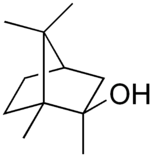2-Methylisoborneol
 | |
| Names | |
|---|---|
| IUPAC name
1,2,7,7-tetramethylbicyclo[2.2.1]heptan-2-ol | |
| Other names
2-Methyl-2-bornanol | |
| Identifiers | |
3D model (JSmol) |
|
| Abbreviations | MIB |
| ChemSpider | |
PubChem CID |
|
| |
| |
| Properties | |
| C11H20O | |
| Molar mass | 168.28 g/mol |
Except where otherwise noted, data are given for materials in their standard state (at 25 °C [77 °F], 100 kPa). | |
| Infobox references | |
2-Methylisoborneol (MIB) is an organic chemical with a strong odor. It is a derivate of borneol. Its odor detection threshold is very low and it is one of the chemicals with major influence on the quality of drinking water. MIB is also a factor in cork taint in winemaking.
Some algae, particularly blue-green algae (cyanobacteria) such as Anabaena, produce MIB together with other odorous chemicals such as geosmin.[1] They give a musty or earthy odor that can be quite strong if an algal bloom is present. Subsequent death of the cyanobacteria will also release MIB that is trapped in the cells. These chemicals can be smelled at very low levels, in the parts-per-trillion range (ppt range), and are responsible for many "taste and odor" issues in drinking water treatment and distribution. Along with geosmin, the off flavors caused are issues in the seafood industry. This chemical is the major cause of "muddy" or "dirt" flavors in catfish and crawfish.[2] Cyanobacteria can also produce chemical toxins that have been a problem in drinking water in some cases.
References
- ↑ Izaguirre and Taylor (2004). "A Guide to Geosmin and MIB-producing Cyanobacteria in the United States". Water Science and Technology. 49 (9): 19–24.
- ↑ Lloyd, Steven W; Grimm, Casey C (1999). "Analysis of 2-Methylisoborneol and Geosmin in Catfish by Microwave Distillation−Solid-Phase Microextraction". Journal of Agricultural and Food Chemistry. 47: 164–169. doi:10.1021/jf980419x.